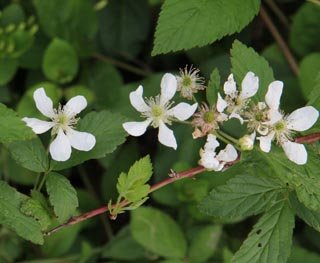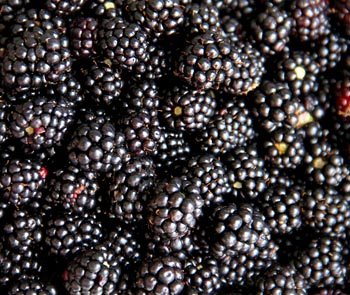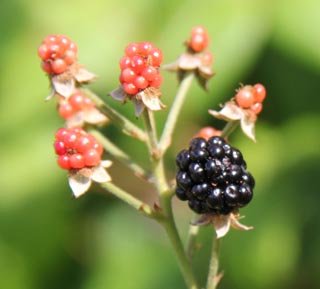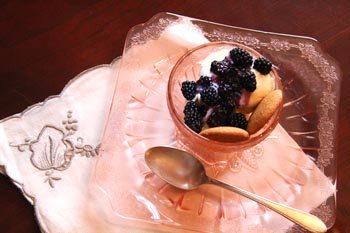





July means blackberries where I'm from, so let's look into some interesting facts and lore about this yummy fruit. First of all, it isn't a berry....
A blackberry is an aggregate fruit made up of drupes. Each little seed filled 'bump' is a drupe. So, while last week's eggplant is a berry, this week's blackberry is not.
 Blackberries are perennial plants native to most temperate regions in Northern Hemisphere and have naturalized world-wide. Australia, New Zealand and Chile consider it invasive. Ancient records and archaeological evidence indicate that humans have been using blackberries for food, medicine and dyes for over 2000 years. They have also been part of mythology and tales for just as long. It was said that when Lucifer was cast down from Heaven, he landed in blackberry brambles. He hated them so much that he stomps the plants with his feet every Michaelmas Day and the myth warns of eating the fruit after that date. Legend also says that the crown of thorns placed on the head of Jesus was blackberry thorns and the fruits turn from red to black out of shame. The ancient Greeks believed that Bellerophon was blinded by blackberry brambles when he was thrown from Pegasus and was doomed to wander helpless for the rest of his days.
Blackberries are perennial plants native to most temperate regions in Northern Hemisphere and have naturalized world-wide. Australia, New Zealand and Chile consider it invasive. Ancient records and archaeological evidence indicate that humans have been using blackberries for food, medicine and dyes for over 2000 years. They have also been part of mythology and tales for just as long. It was said that when Lucifer was cast down from Heaven, he landed in blackberry brambles. He hated them so much that he stomps the plants with his feet every Michaelmas Day and the myth warns of eating the fruit after that date. Legend also says that the crown of thorns placed on the head of Jesus was blackberry thorns and the fruits turn from red to black out of shame. The ancient Greeks believed that Bellerophon was blinded by blackberry brambles when he was thrown from Pegasus and was doomed to wander helpless for the rest of his days.
 There were some unusual medical uses for the blackberry. It was noted in ancient texts that if the leaves and roots were gathered during a specific moon phase, the tea would protect against spells and curses. Also, by creating an archway out of the brambles, anyone or anything that passed under it would be cured of anything from hernias and boils to various diseases livestock might contract. Yes, they led their cows and sheep through the bramble archway to cure sickness.
There were some unusual medical uses for the blackberry. It was noted in ancient texts that if the leaves and roots were gathered during a specific moon phase, the tea would protect against spells and curses. Also, by creating an archway out of the brambles, anyone or anything that passed under it would be cured of anything from hernias and boils to various diseases livestock might contract. Yes, they led their cows and sheep through the bramble archway to cure sickness.
However, there are actual curative properties to the plant. The leaves and roots are high in tannin and the tea was consumed to help sore throats, ulcers, whooping cough and labor pains. Many people used the tea to soothe a number of inflammations in the gut and it was an old treatment for gout. In fact, one of the ancient names for this plant is 'goutberry'. Most people find the tea very bitter and honey was often added to make the medicine more palatable. The plant also contains salicylic and ellagic acids which are used today to treat skin problems and medical research is experimenting with some cancer treatments containing blackberry compounds as well.
 Native Americans created a fairly strong rope from the fibers in the stems and many peoples around the world planted the brambles around their villages to discourage predators and enemies from attack. Blackberries were also a popular dye plant. The roots produce an orange dye, the stems tan and the berries produce black if lye is used as a mordant and gray if alum is used.
Native Americans created a fairly strong rope from the fibers in the stems and many peoples around the world planted the brambles around their villages to discourage predators and enemies from attack. Blackberries were also a popular dye plant. The roots produce an orange dye, the stems tan and the berries produce black if lye is used as a mordant and gray if alum is used.
Blackberry canes are biennial. This means that for the first year, the cane puts out top growth and the second year, lateral branches form on those canes that produce fruit. It is possible for blackberries to root where the canes touch the ground. This produces vast thickets if left unchecked. The good thing is, these thickets provide shelter and the berries provide food for many mammals and birds. Even deer will browse the leaves and the fruits where they are easy to reach, but for the most part, they tend to avoid them. Blackberries bloom in mid-spring and are usually ripe in early summer and the white flowers are an early source of pollen and nectar for the local honeybees.
 There are a number of commercial cultivars available and some are even thornless. Check with your local nursery or County Extension Office to see which cultivars grow best for your particular region. Most blackberry cultivars do well in a sunny, fertile, well-drained area that receives an ample amount of moisture. Plant as early in the spring as possible and cut the canes back to about a hand's height. There will not be any berries the first year., but you should get a harvest the next year. Your canes will increase from underground runners each year and harvest size will increase proportionally. Thin dead and unproductive canes in early spring.
There are a number of commercial cultivars available and some are even thornless. Check with your local nursery or County Extension Office to see which cultivars grow best for your particular region. Most blackberry cultivars do well in a sunny, fertile, well-drained area that receives an ample amount of moisture. Plant as early in the spring as possible and cut the canes back to about a hand's height. There will not be any berries the first year., but you should get a harvest the next year. Your canes will increase from underground runners each year and harvest size will increase proportionally. Thin dead and unproductive canes in early spring.
Whether you purchase commercial cultivars or do it the old-fashioned way by heading into the woods, be aware that snakes, ticks and chiggers like to hang out in the brambles, so plan accordingly. If picking wild berries, be sure to obtain permission from the land-owner. It isn't very neighborly of you to pick their Sunday blackberry cobbler!
Copyright © www.100flowers.win Botanic Garden All Rights Reserved